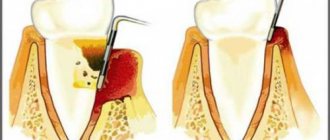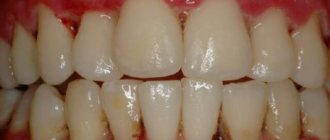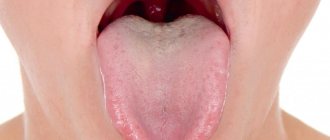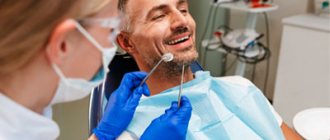Inflammation of the part of the gums adjacent to the teeth is called gingivitis. Accompanied by bleeding gums, gingivitis is often confused with periodontitis, but in the latter case the disease leads to the destruction of bone tissue. Periodontitis is the result of neglected gingivitis.
Gingivitis happens:
- catarrhal;
- hypertrophic;
- ulcerative-neurotic.
Each of these forms has its own distinctive characteristics and methods of treatment.
Gingivitis in adults: causes of the disease
The disease, which affects all categories of people (children, adults, pregnant women), occurs primarily due to weakened immunity and poor oral hygiene.
The development of the inflammatory process occurs at a low speed, so the disease is often not noticeable for a long time to an ordinary person who is far from dentistry. However, if you do not consult a doctor in a timely manner, serious complications may develop, which can lead to a more painful course of the disease and lengthy treatment.
There are three stages of development of gingivitis:
- mild (the disease affects only the spaces between the teeth);
- medium (the disease affects the edge of the gum);
- heavy.
The more time passes without treatment, the further the lesion spreads, eventually covering the oral mucosa.
The causes of the disease are divided into internal and external.
External ones include:
- injuries;
- burns of the oral cavity;
- influence of radiation;
- effects of heavy metals on the human body.
The internal reasons are as follows:
- development of molars (often during their growth, soft tissues are injured, which causes bleeding);
- lack of vitamins and minerals in the diet, which leads to decreased immunity;
- gastrointestinal diseases;
- various infections;
- neglected carious formations.
Diagnostic features
Gingivitis can be recognized visually—sometimes one examination by a doctor is enough. But you should make sure that there are no more serious pathologies, so diagnosis may include not only a visual assessment of the condition of the oral cavity, but also other measures:
- collecting anamnesis, assessing the condition of structures in the oral cavity;
- probing of periodontal pockets if present;
- determination of tooth mobility;
- electroodontodiagnosis to determine the condition of the dental pulp;
- panoramic x-ray or targeted x-ray - to exclude periodontitis, periostitis and other pathologies of deep structures, jaw bone tissue, etc.
It is important to take into account the presence of chronic diseases and medications. Only with complete information can a doctor make an accurate diagnosis and develop an effective treatment regimen.
Symptoms of gingivitis in adults
The onset of the disease is indicated by a feeling of discomfort that occurs in the oral cavity. The affected area turns red and may increase in volume. While brushing your teeth and eating solid foods, some bleeding is allowed, but there is no pain at this stage yet. Increased salivation may occur.
Gradually, the inflamed gum begins to lag behind the tooth, and food debris accumulates in the resulting gap, which leads to the formation of an unpleasant odor. If treatment is ignored, the resulting pocket may develop tooth decay.
At this stage, pain begins to appear, which intensifies while eating (especially when eating hot or cold food). Often inflammation can be accompanied by increased body temperature, a feeling of weakness, and increased irritability.
During the examination, accumulated plaque or caries is clearly visible in the area of inflammation. Blood may be released during a dental examination.
If the disease has become chronic, then the above symptoms may not be so clearly expressed, but it is impossible not to notice hypertrophied soft tissues.
What can cause gums to become inflamed?
The first and most important cause of gum inflammation is poor quality or irregular dental care. Daily brushing of teeth, rinsing the mouth with special balms and other means help prevent the development of bacteria. If you brush your teeth poorly, a lot of microorganisms accumulate in hard-to-reach places, which gradually penetrate the gums, causing inflammation, which can lead to very serious oral problems, including tooth loss.
Another fairly common cause is hormonal imbalance and weak immunity. A person is especially vulnerable after suffering from diseases such as ARVI, smallpox, etc., which directly affect the body and weaken its protective functions. In this regard, even with careful and regular brushing of teeth, people with weakened immune systems are especially susceptible to the development of pathogenic microflora in the oral cavity. Disruptions in the functioning of hormones are observed during pregnancy, during the restructuring of the body during adolescence, and in women during menopause. In addition to conducting basic medical examinations during these periods of time, it is also advisable to visit the dentist quite often.
Also, gums can become inflamed in people who are genetically predisposed to this, in people suffering from diabetes and gastrointestinal disorders.
Catarrhal gingivitis: symptoms and treatment
The main reason for its development lies in poor hygiene. Plaque accumulates on the surface of the teeth, including on their necks, which gradually hardens, turning into stone.
In addition to neglect of hygiene, catarrhal gingivitis can be caused by a lack of vitamin C in the body, hormonal imbalances and blood diseases. This form of the disease is the most common, occurring very often in women carrying a child.
The disease can be distinguished by the following symptoms:
- swelling of the gum edge, its redness or cyanosis;
- bleeding and pain during cleaning;
- plaque visible to the naked eye.
Catarrhal gingivitis can be:
- acute - this condition is characterized by the rapid development of symptoms;
- chronic, when the symptoms are mild, exacerbating only during periods of weakened immunity (for example, during a cold).
Catarrhal gingivitis: treatment in adults
Since the cause of gingivitis is plaque, the first step is to eliminate it. You can get rid of it by using a regular brush, but if the plaque has managed to mineralize and turn into stone, then you will have to spend time visiting the dentist.
Plaque mineralizes within less than 16 hours from the moment it forms: this is how tartar appears.
So, the main stages of treatment:
- Removing plaque and tartar. Ultrasonic cleaning has proven itself to be the best, after which it is imperative to undergo the procedure of polishing the teeth and treating the gums with gel. Typically, the total session duration is one hour. As practice shows, even after completing this stage of the treatment process, the patient feels much better.
- Anti-inflammatory therapy. Since catarrhal gingivitis affects only the surface of the gums, treatment can be carried out at home. It takes 10 days, then you will need to visit the doctor again for a follow-up examination. In most cases, anti-inflammatory gels are prescribed, which should be applied to the gums, rinses with Chlorhexidine, and a special toothpaste.
Description of anti-inflammatory therapy
For gingivitis treatment to be effective, it is recommended to treat the gums twice a day. Of the wide variety of gels, it is worth using “Cholisal Gel”, and using Chlorhexidine 0.05% as a rinse solution. The widely advertised Metrogyl Denta gel is slightly less effective.
The procedure is as follows: after waking up, routinely brushing your teeth (it is better to buy a Soft brush during treatment) and breakfast, you should thoroughly rinse your mouth with Chlorhexidine, then dry the surface of the gums with gauze and rub it with your finger. The gel should be applied both from the outside of the teeth and from the tongue. After treating your gums with gel, you should not drink or eat for at least half an hour. Some components of the product can cause salivation: saliva can be swallowed without fear, since it does not contain anything harmful to health.
It is necessary to clearly understand that curing gingivitis and then returning to your previous lifestyle means dooming yourself to the recurrence of symptoms in the near future. To prevent this from happening, prevention is important, which consists of properly brushing your teeth after every meal. Minimizing the risk of relapse is also influenced by the absence of caries, so carious cavities must be healed.
How to cure gum gingivitis at home
It is worth treating at home only if the dentist has already examined the oral cavity, conducted the necessary diagnostic tests, studied the medical history and made recommendations that will help get rid of the unpleasant illness. Along with medications, the patient can use folk recipes that have been proven over the years. However, such drugs, despite their relative safety, can cause adverse reactions due to intolerance to the components and for other reasons. Therefore, the dentist must calculate the dosage himself and advise which herbal decoctions and solutions will not cause harm and are highly effective.
It is important to adhere to a special diet and include fruits and vegetables such as:
- citrus fruits (contain a lot of vitamin C, which helps strengthen vascular walls and prevent bleeding);
- apples, pears (include pectin, which accelerates the restoration of soft tissues);
- currants, raspberries and other berries (increase human immunity);
- zucchini, cabbage, carrots and other vegetables (accelerate metabolic and regeneration processes due to the fiber and antioxidants they contain).
You should exclude fast carbohydrates, baked goods, sweets, and potato dishes from the menu. They lead to the formation of thick plaque on the teeth, and subsequently - tartar.
Anti-gingivitis medications
In some cases, antibiotics cannot be avoided. However, all prescriptions should be made exclusively by the attending physician based on the clinical picture, the patient’s medical history, his well-being and other manifestations. Most often Amoxicillin, Metronidazole, and Erythromycin are used for these purposes.
Local agents
Gel and cream medications significantly alleviate the manifestations of the disease. These are anti-inflammatory compounds for external use such as Cholisal, Solcoseryl, Metrogyl Denta, Asepta and others.
Traditional methods
Some people, when the first symptoms of pathology appear, try to find information on the Internet and old books at home on how to treat gum gingivitis at home without pharmaceutical drugs. It should be remembered once and for all - no “grandmother’s” recipes, even if they show high effectiveness, should not be used without the approval of a doctor.
In combination with medications and other means, herbal medicine will help to significantly speed up recovery. Let's look at methods for preparing medicinal decoctions and solutions, often recommended by doctors.
- Pour 1 tbsp. l. sage with a glass of boiling water, leave for half an hour. When the composition has cooled to room temperature, it is necessary to strain it through cheesecloth or a sieve. Rinse every time after eating.
- Prepare an aqueous solution from 1 tsp. baking soda per glass of warm liquid. You need to rinse your mouth with this mixture to remove leftover food.
- Mix 2 tablespoons of crushed oak bark and dried celandine, pour boiling water (about 400 ml). It is necessary to rinse the mouth well 4 times a day until the unpleasant manifestations of the pathology completely disappear.
Vitamins
Taking vitamin and mineral supplements is an integral part of complex therapy. Doctors usually issue orders for the purchase of pharmaceutical products containing substances of groups C and P (Ascorbic acid, Ascorutin, etc.).
Necrotizing ulcerative gingivitis: symptoms and treatment in adults
The cause of the disease, as in the previous case, is non-compliance with hygiene, which has taken a critical form.
Due to the increase in plaque volume, gum necrosis develops. This often occurs against the background of decreased immunity or exacerbation of chronic diseases.
The first sign of ulcerative necrotic gingivitis is areas of ulceration on the gums and an increase in temperature to 39 degrees. Headaches and smell of rotting breath are possible.
This form of the disease should be treated by a dentist, and on an emergency basis. Dental plaque is removed along with the gray-greenish plaque, strong antibiotics are prescribed, then, when the inflammation subsides, gels are prescribed to accelerate the healing and restoration of the mucous membrane.
If inflammation is not stopped at the very beginning, full recovery may not occur?
Absolutely right. At the stage of inflammatory changes in the deep periodontal tissues, complete recovery cannot be achieved; the disease can only be brought into stable remission - a state when patients do not complain. It is characterized by the absence of bleeding gums, bad breath and decreased tooth mobility. Further therapeutic and preventive measures are aimed at maintaining the protective forces of the periodontal tissues and preventing the formation of dental plaque. To do this, control courses of maintenance therapy are carried out at intervals of two to three months. Then the interval between them increases to five to six months.
Hypertrophic gingivitis: symptoms, treatment methods
It is characterized by fibrous growth or an increase in the volume of the gums due to swelling. Occurs due to disturbances in the endocrine system, hormonal imbalances and malocclusion.
Treatment will depend on the form of the disease:
- the edematous form involves the use of sclerotherapy, that is, when a special solution consisting of glucose, calcium chloride and magnesium sulfate is injected into the gingival papillae. The procedure is carried out with anesthesia; at least 3 injections are required into each papilla with a break of 2 days.
- in the fibrotic form, deposits are removed and factors traumatic to the gums are eliminated, then anti-inflammatory therapy is prescribed, including applying bandages with heparin ointment and other medications.
Gingivitis: Common Treatments in Adults
Regardless of the type of disease, there are general treatment methods:
- To diagnose the disease, the degree of contamination of the surface of the teeth is assessed. To determine the amount of plaque, special tinting compounds are used - the affected areas change color, which allows the doctor to accurately determine the extent of the problem;
- the patient is selected with the most suitable toothpaste and brush, and is also told about the need to adjust their diet (for example, if a person avoids solid food, this can lead to the accumulation of pathogenic microflora in the spaces between the teeth);
- Professional teeth cleaning is carried out using modern methods (usually ultrasound and further polishing of the cervical area are used);
- the affected tissues are treated with medications, and surgical intervention is used if necessary;
- When chronic diseases are detected, the patient is sent to specialists for further treatment.
What measures should be taken to prevent gum disease?
First of all, regular and thorough oral hygiene is necessary. To do this, you need to choose a good toothbrush, not one whose color will match the color scheme of your bath, but one that will meet your requirements: softness, fiber material, size of the working surface. For example, an ultrasonic brush would be ideal for problem gums. Toothpaste is also important; your dentist will help you choose it, knowing your problem areas and hygiene needs. Every day it is necessary to remove plaque from the interdental spaces using dental floss and use a mouth rinse: its antiseptic properties destroy pathogens, and its anti-inflammatory effect produces a calming effect.
If you notice the first signs of gingivitis, you should urgently consult a periodontist. In addition, do not forget to regularly undergo preventive examinations twice a year, then any process can be stopped even before symptoms appear.











